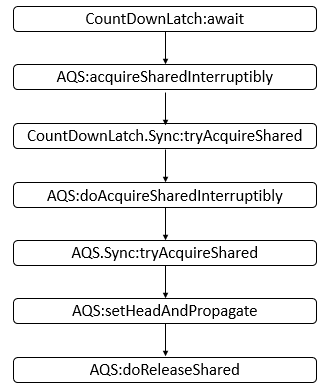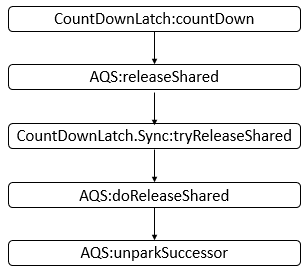Java并发和多线程-JUC工具类-CountDownLatch
带着BAT大厂的面试问题去理解
- 什么是CountDownLatch?
- CountDownLatch底层实现原理?
- CountDownLatch一次可以唤醒几个任务? 多个
- CountDownLatch有哪些主要方法? await(),countDown()
- CountDownLatch适用于什么场景?
- 写道题:实现一个容器,提供两个方法,add,size 写两个线程,线程1添加10个元素到容器中,线程2实现监控元素的个数,当个数到5个时,线程2给出提示并结束? 使用CountDownLatch 代替wait notify 好处。
CountDownLatch介绍
从源码可知,其底层是由AQS提供支持,所以其数据结构可以参考AQS的数据结构,而AQS的数据结构核心就是两个虚拟队列: 同步队列sync queue 和条件队列condition queue,不同的条件会有不同的条件队列。
CountDownLatch典型的用法是将一个程序分为n个互相独立的可解决任务,并创建值为n的CountDownLatch。
等待问题被解决的任务调用这个锁存器的await(),将自己拦住,直至锁存器计数结束。
当每一个任务完成时,都会在这个锁存器上调用countDown()。
源码分析
类的继承关系
CountDownLatch没有显示继承哪个父类或者实现哪个父接口, 它底层是AQS提供支持,是通过内部类Sync来实现的。
1 | public class CountDownLatch { |
内部类
CountDownLatch类存在一个内部类Sync,继承自AbstractQueuedSynchronizer。
对CountDownLatch方法的调用会转发到对Sync或AQS的方法的调用,所以,AQS对CountDownLatch提供支持。
1 | private static final class Sync extends AbstractQueuedSynchronizer { |
类的属性和构造函数
1 | public class CountDownLatch { |
- 可以看到CountDownLatch类的内部只有一个Sync类型的属性。
- 该构造函数可以构造一个给定计数初始化的CountDownLatch,并且构造函数内完成了sync的初始化,并设置了状态数。
核心函数 await()
此函数将会使当前线程在锁存器倒计数至零之前一直等待,除非线程被中断。
1 | public void await() throws InterruptedException { |
对CountDownLatch对象的await的调用会转发为对Sync的acquireSharedInterruptibly(从AQS继承的方法)方法的调用。
CountDownLatch的await调用链:
AQS#acquireSharedInterruptibly
1
2
3
4
5
6public final void acquireSharedInterruptibly(int arg) throws InterruptedException {
if (Thread.interrupted())
throw new InterruptedException();
if (tryAcquireShared(arg) < 0)
doAcquireSharedInterruptibly(arg);
}acquireSharedInterruptibly又调用了CountDownLatch的内部类Sync的tryAcquireShared和AQS的doAcquireSharedInterruptibly函数。
CountDownLatch#Sync#tryAcquireShared
1
2
3protected int tryAcquireShared(int acquires) {
return (getState() == 0) ? 1 : -1;
}该函数只是简单的判断AQS的state是否为0,为0则返回1,不为0则返回-1。
AQS#doAcquireSharedInterruptibly
1
2
3
4
5
6
7
8
9
10
11
12
13
14
15
16
17
18
19
20
21
22
23
24
25
26
27
28
29
30private void doAcquireSharedInterruptibly(int arg) throws InterruptedException {
// 添加节点至等待队列
final Node node = addWaiter(Node.SHARED);
boolean failed = true;
try {
for (;;) { // 无限循环
// 获取node的前驱节点
final Node p = node.predecessor();
if (p == head) { // 前驱节点为头节点
// 试图在共享模式下获取对象状态
int r = tryAcquireShared(arg);
if (r >= 0) { // 获取成功
// 设置头节点并进行繁殖
setHeadAndPropagate(node, r);
// 设置节点next域
p.next = null; // help GC
failed = false;
return;
}
}
if (shouldParkAfterFailedAcquire(p, node) &&
parkAndCheckInterrupt()) // 在获取失败后是否需要禁止线程并且进行中断检查
// 抛出异常
throw new InterruptedException();
}
} finally {
if (failed)
cancelAcquire(node);
}
}在AQS的doAcquireSharedInterruptibly中可能会再次调用CountDownLatch的内部类Sync的tryAcquireShared方法和AQS的setHeadAndPropagate方法。
核心函数 countDown()
此函数将递减锁存器的计数,如果计数到达零,则释放所有等待的线程。
1 | public void countDown() { |
对countDown的调用转换为对Sync对象的releaseShared(从AQS继承而来)方法的调用。
CountDownLatch的countDown调用链:
深入理解
实现一个容器,提供两个方法,add,size
写两个线程,线程1添加10个元素到容器中,线程2实现监控元素的个数,当个数到5个时,线程2给出提示并结束.
使用wait和notify实现
1 | import java.util.ArrayList; |
CountDownLatch实现
1 | import java.util.ArrayList; |